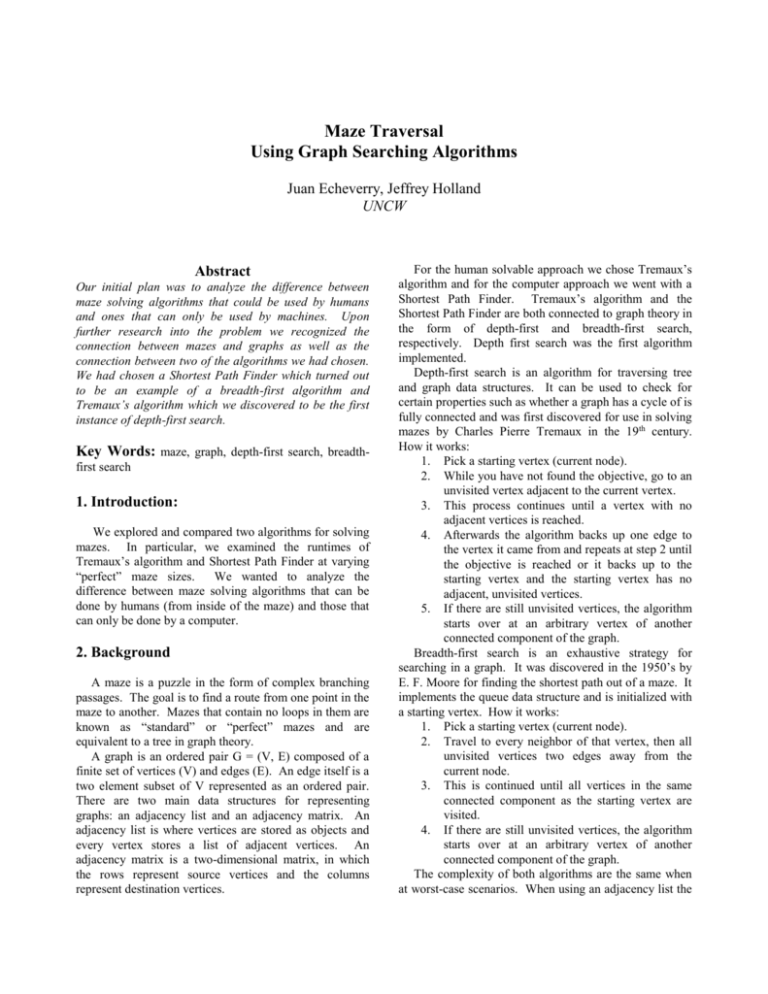
Maze Traversal
Using Graph Searching Algorithms
Juan Echeverry, Jeffrey Holland
UNCW
Abstract
Our initial plan was to analyze the difference between
maze solving algorithms that could be used by humans
and ones that can only be used by machines. Upon
further research into the problem we recognized the
connection between mazes and graphs as well as the
connection between two of the algorithms we had chosen.
We had chosen a Shortest Path Finder which turned out
to be an example of a breadth-first algorithm and
Tremaux’s algorithm which we discovered to be the first
instance of depth-first search.
Key Words: maze, graph, depth-first search, breadthfirst search
1. Introduction:
We explored and compared two algorithms for solving
mazes. In particular, we examined the runtimes of
Tremaux’s algorithm and Shortest Path Finder at varying
“perfect” maze sizes.
We wanted to analyze the
difference between maze solving algorithms that can be
done by humans (from inside of the maze) and those that
can only be done by a computer.
2. Background
A maze is a puzzle in the form of complex branching
passages. The goal is to find a route from one point in the
maze to another. Mazes that contain no loops in them are
known as “standard” or “perfect” mazes and are
equivalent to a tree in graph theory.
A graph is an ordered pair G = (V, E) composed of a
finite set of vertices (V) and edges (E). An edge itself is a
two element subset of V represented as an ordered pair.
There are two main data structures for representing
graphs: an adjacency list and an adjacency matrix. An
adjacency list is where vertices are stored as objects and
every vertex stores a list of adjacent vertices. An
adjacency matrix is a two-dimensional matrix, in which
the rows represent source vertices and the columns
represent destination vertices.
For the human solvable approach we chose Tremaux’s
algorithm and for the computer approach we went with a
Shortest Path Finder. Tremaux’s algorithm and the
Shortest Path Finder are both connected to graph theory in
the form of depth-first and breadth-first search,
respectively. Depth first search was the first algorithm
implemented.
Depth-first search is an algorithm for traversing tree
and graph data structures. It can be used to check for
certain properties such as whether a graph has a cycle of is
fully connected and was first discovered for use in solving
mazes by Charles Pierre Tremaux in the 19th century.
How it works:
1. Pick a starting vertex (current node).
2. While you have not found the objective, go to an
unvisited vertex adjacent to the current vertex.
3. This process continues until a vertex with no
adjacent vertices is reached.
4. Afterwards the algorithm backs up one edge to
the vertex it came from and repeats at step 2 until
the objective is reached or it backs up to the
starting vertex and the starting vertex has no
adjacent, unvisited vertices.
5. If there are still unvisited vertices, the algorithm
starts over at an arbitrary vertex of another
connected component of the graph.
Breadth-first search is an exhaustive strategy for
searching in a graph. It was discovered in the 1950’s by
E. F. Moore for finding the shortest path out of a maze. It
implements the queue data structure and is initialized with
a starting vertex. How it works:
1. Pick a starting vertex (current node).
2. Travel to every neighbor of that vertex, then all
unvisited vertices two edges away from the
current node.
3. This is continued until all vertices in the same
connected component as the starting vertex are
visited.
4. If there are still unvisited vertices, the algorithm
starts over at an arbitrary vertex of another
connected component of the graph.
The complexity of both algorithms are the same when
at worst-case scenarios. When using an adjacency list the
complexity is O (|V| + |E|), where V and E are the vertices
and edges of the graph, and O (V²|) when using an
adjacency matrix. The worst case scenario would be
where the starting vertex is at the furthest connected point
in the graph from the end vertex and every other vertex
and edge would have to be traversed before being
reached.
3. Methods
We generated our mazes using a randomized
implementation of Prim’s algorithm. This generated
“perfect” mazes for our tests. Prim’s algorithm, a greedy
algorithm, is used for finding minimum spanning trees for
connected, weighted, and undirected graphs.
The
complexity for Prim’s is:
Adjacency list: O (|V| + |E|)
Adjacency matrix: O (|V²|)
The maze generation did not have an impact on our
direction besides ensuring a level field for analysis. Both
of the chosen algorithms can be used for mazes other than
perfect but for our purposes, this was not necessary.
These algorithms guarantee solutions, if they exist in the
given problem.
Tremaux’s algorithm, our human approach, differs
from depth-first search in a few ways. The algorithm
itself gives some context into how they differ. Following
is the exact language used for the implementation of our
version of Tremaux’s algorithm:
As you walk down a passage, draw a line behind
you to mark your path.
When you hit a dead end turn around and go
back the way you came.
When you encounter a junction you haven't
visited before, pick a new passage at random.
If you're walking down a new passage and
encounter a junction you have visited before, treat it
like a dead end and go back the way you came.
If walking down a passage you have visited
before (i.e. marked once) and you encounter a
junction, take any new passage if one is available,
otherwise, take an old passage (i.e. one you've
marked once).
All passages will either be empty, meaning you
haven't visited it yet, marked once, meaning you've
gone down it exactly once, or marked twice,
meaning you've gone down it and were forced to
backtrack in the opposite direction.
When you finally reach the solution, paths
marked exactly once will indicate a direct way back
to the start.
If the Maze has no solution, you'll find yourself
back at the start with all passages marked twice.
Notice that Tremaux’s algorithm does not contain an
explicit stack. Rather, it achieves the same functionality
through marking passageways as they are visited. In
worst-case scenario, you would have to visit every cell
(vertex) twice, except for the path to the exit.
A Shortest Path Finder algorithm was used for the
computer approach. Where this one differs from breadthfirst search is in the fact that each vertex keeps track of
how it was reached. Meaning, it knows what vertex was
used in order to get to it and this is used in traversing back
from the end vertex. In worst case scenario, you would
have to visit every cell.
We first used the maze generator to produce mazes of
varying sizes, 10, 80, and 200. At these different sizes,
time stamps were taken before and after each
implementation of our search algorithms and the
difference was used in creating graphs of the results. At
each size, we did 100 runs to record an average time but
cut off the first 10 runs of each data set because the results
were skewed to be far longer than they should have been.
We were unable to determine what cause this besides the
time taken to allot processing power to the program. We
graphed the individual runtimes at each size in order to
observe if there were any runs where the human approach
was faster than the computer approach.
After observing this, we switched from observing
individual runtimes to the average runtimes. We started
generating mazes of size 10 x 10 and increased by 10 until
we reached mazes of size 800 x 800. To save time, we
did 30 runs and not 100 runs at each size. We graphed the
average runtime at each size this time to see if we could
notice the near linear increase we were expecting.
4. Results & Analysis
When comparing the two in terms of average runtime,
the Shortest Path Finder algorithm took the least amount
of time to complete. While there were individual runs that
Tremaux’s had a significant faster time, this was mostly
due to random chance.
At smaller size mazes, our implementation of Shortest
Path Finder is close to twice as fast as Tremaux’s
algorithm. When comparing the two algorithms, this can
be seen as resulting from the fact that Shortest Path
Finder, despite the fact that it visits more cells (vertices)
on average, visits each cell only once. Tremaux’s on the
other hand visits a significant portion of the cells twice
due to backtracking. As the size of the mazes increase,
the 2:1 time ratio, Tremaux’s to Shortest Path, seen at
smaller numbers begins to decrease. This is where the
amount of memory space that the Shortest Path Finder
uses becomes a larger weight than the fact that it only
visits each cell once.
5. Conclusion
The Shortest Path Finder algorithm worked best within
the scope of this project where memory, at the size of
maze we went up to, was not an issue but had it been, we
believe Tremaux’s would be a better choice. The deeper
we dove into the world of mazes we realized it had much
more of a connection to graph theory than we initially
thought. The fact that a maze is nothing more than a tree,
or type of graph, all of the rules that govern graph theory
apply to mazes. This maze project pointed us towards key
realizations in the interconnectedness of seemingly
disparate problem fields. Future work we would like to
pursue includes optimization, in the form of
parallelization and heuristics, and exploring the
complexity of adding dimensions.
Figure 1b) Graph representation of the maze
N = 10
1400
1200
[1] Levitin, Anany. Introduction to the Design & Analysis
of Algorithms. 3rd ed. Boston: Pearson Addison-Wesley,
2007. Print.
[2] Pullen, Walter D. "Think Labyrinth: Maze
Algorithms." Think
Labyrinth:
Maze
Algorithms.
Magitech, 01 Nov. 2014. Web. 03 Dec. 2014.
1000
Time (µs)
6. References
800
Tremaux
600
Shortest
400
200
0
1
11
21
31
41
51
61
71
81
Figure 2: Runtimes in µs at 10 x 10 mazes
N = 80
7. Images and Graphs
6000
5000
Time (µs)
4000
Tremaux
3000
Shortest
2000
1000
0
1
11
21
31
41
51
61
71
81
Figure 3: Runtimes in µs at 80 x 80 mazes
Figure 1a) Maze with vertices labeled
N = 200
30000
25000
Time (µs)
20000
Tremaux
15000
Shortest
10000
5000
0
1
11
21
31
41
51
61
71
81
Figure 4: Runtimes in µs at 200 x 200 mazes
Figure 5: Avg. Runtimes across N x N mazes from N =
10 to N = 800, in increments of 10










